
The Extra Flugzeugbau EA300 is a two-seat aerobatic monoplane capable of Unlimited category competition. It was designed in 1987 by Walter Extra, a German aerobatic pilot, and built by Extra Flugzeugbau.

The Extra 200 is a two-seat, tandem arrangement, low-wing aerobatic monoplane with conventional (taildragger) landing gear fully capable of Unlimited category competition, built by Extra Flugzeugbau.

The Zlin Z-50 is an aerobatic sports airplane built by the Czechoslovakian company Zlin Aircraft.

The American Champion 8KCAB Decathlon and Super Decathlon are two-seat fixed conventional gear light airplanes designed for flight training and personal use and capable of sustaining aerobatic stresses between +6g and −5g. The Decathlon entered production in the United States in 1970 as a more powerful and stronger complement to the American Champion Citabria line of aircraft.

The Diamond DA40 Diamond Star is an Austrian four-seat, single-engine, light aircraft constructed from composite materials. Built in both Austria and Canada, it was developed as a four-seat version of the earlier DA20 by Diamond Aircraft Industries.
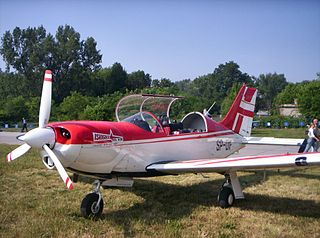
PZL M26 Iskierka or M26 Airwolf is a Polish trainer and aerobatic aircraft, designed at WSK PZL-Mielec.

The Mudry CAP 10 is a two-seat training aerobatic aircraft first built in 1970 and still in production in 2007. The plane was developed from the Piel Super Emeraude and was born as the CP100. The name changed to CAP 10, CAP for 'Constructions Aéronautiques Parisiennes'. The CAP 10 was manufactured by Mudry in Bernay, France, bought by CAP Industries which then became Apex Aircraft. Following the bankruptcy of Apex in 2008, rights to produce spares were awarded to Dyn'Aviation. After the bankruptcy of DynAero in 2012, manufacture of spares was taken over by CEAPR in Darois.

The AS/SA 202 Bravo is a two to three-seat civil light aircraft jointly designed and manufactured by the Swiss company Flug- und Fahrzeugwerke Altenrhein (FFA) and the Italian company Savoia-Marchetti. The aircraft was designated the AS 202 in Switzerland, and the SA 202 in Italy.

The Christen Eagle, which later became the Aviat Eagle in the mid-1990s, is an aerobatic sporting biplane aircraft that has been produced in the United States since the late 1970s.

The Extra 230 was a single-seat aerobatic aircraft developed in Germany in the early 1980s. Designed by aerobatic pilot Walter Extra based on the layout of the Laser 200 he was previously flying, the Extra 230 was a conventional mid-wing cantilever monoplane with fixed tailwheel undercarriage and a wire-braced empennage. The fuselage and empennage were of steel tube construction, but the wings were wooden. Production continued until 1990, at which time it was replaced by the Extra 300
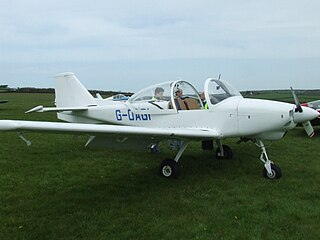
The Sprint is a light aircraft developed in the United Kingdom in the 1980s, originally known as the Trago Mills SAH-1. It was produced by FLS Aerospace in two versions, the Club Sprint, and the Sprint 160. In both versions, it is a low wing, two seat, monoplane designed as an advanced aerobatic trainer with +6/-3 g capability. The aircraft is a fully aerobatic trainer similar to the Grob G 115 or the Slingsby Firefly, although it is of conventional riveted aluminium construction rather than the composite construction of the other two aircraft.

The Maule M-7 is a family of single-engine light aircraft that has been manufactured in the United States since the mid-1980s.
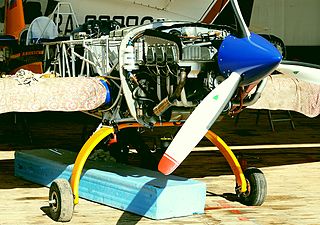
The Lycoming IO-580 engine is a horizontally opposed, six-cylinder aircraft engine featuring three cylinders per side, manufactured by Lycoming Engines.
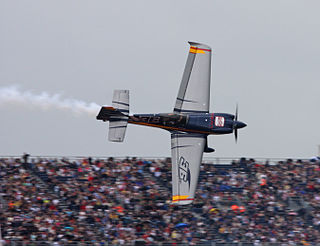
The MXS is a single-seat aerobatic aircraft made of carbon fiber and built by MX Aircraft Company, a manufacturer located at Jandakot Airport in Perth, Western Australia. The MXS-R is a race variant flown by several pilots in the Red Bull Air Race World Championship. The planes are all-composite in construction, piston-powered, low-wing monoplanes. They are produced both in kit form for amateur construction, and completed ready to fly at the factory.

The Dyn'Aéro CR.100 is a French kit built single engine, two-seat monoplane, developed in the 1990s and intended as both an aerobatic trainer and a tourer, primarily for aero club use.

The XtremeAir Sbach 342 (XA42) is a German high performance two-seat aerobatic and touring monoplane designed by Philipp Steinbach with Albert Mylius and built by XtremeAir GmbH of Hecklingen.

The MSW Votec 322 is a Swiss two-seat low-wing monoplane based on the Rihn DR-107 One Design and designed for amateur construction by MSW Aviation of Wohlen.
The Swift Aircraft Swift is a single engine, conventional light aircraft, seating two in side-by-side configuration. It is being developed in the UK but has yet to fly.
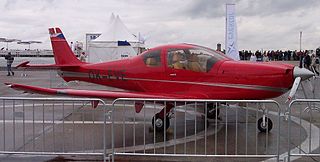
The Evektor VUT100 Cobra is a Czech light aircraft under development by Evektor-Aerotechnik, of Kunovice. The aircraft is intended to be supplied as a complete ready-to-fly-aircraft.

The Game Composites GB1 GameBird is a British single-engine, two-seat, aerobatic aircraft that was designed by Philipp Steinbach and the first prototype was built by Game Composites.



















